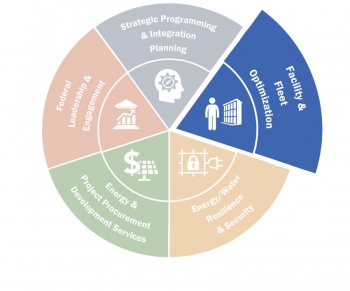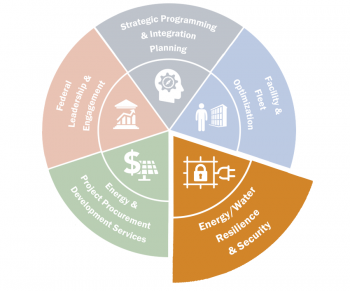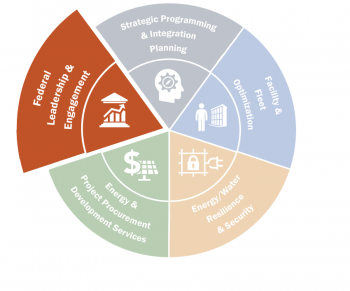With more than 350,000 energy- utilizing buildings and 600,000 vehicles, the federal government is the nation’s largest energy consumer. Energy used in buildings and facilities represents about 36% of the total site-delivered energy use of the federal government, with vehicle and equipment energy use accounting for 60%.
What We Do
Mandated by law, the Federal Energy Management Program (FEMP) focuses on key services that help agencies meet energy- and water-reduction requirements and goals.
| Action | Mandated By | Supporting Federal Priority |
|---|---|---|
| Issue Legislative and Executive Guidance | 42 U.S.C. 8252, 8253, and 8257 | American Prosperity and American Energy Dominance |
| Facilitate Technology Integration | 42 U.S.C. § 8259b | Modernizing and Managing Infrastructure |
| Leverage Funding Sources | 42 U.S.C. § 8287 et seq. | Modernizing and Managing Infrastructure |
| Provide Technical Assistance | 42 U.S.C. § 8257 | American Prosperity and American Energy Dominance |
| Track Agency Accountability | 42 U.S.C. § 17143, 42 U.S.C. 8253-8258, and 42 U.S.C. 15852 | Increasing Government Accountability |
| Develop Accredited Training | 42 U.S.C. 8252 and 8253 | Developing a Future-Focused Workforce |
Mission and Stakeholders
FEMP works with its stakeholders to enable federal agencies to meet energy-related goals, identify affordable solutions, facilitate public-private partnerships, and provide energy leadership to the country by identifying government best practices.

Federal Government Progress
FEMP guides federal agencies to leverage FEMP resources and assistance to spur public-private partnerships and success- fully implement replicable, well-designed projects.
These efforts have resulted in the federal government achieving a 49% reduction in energy intensity since 1975.

Energy consumed in federal government facilities has been generally declining over the past four decades. This reduction stems from the total square footage occupied by the federal government, which has continued to fall since its peak in fiscal year (FY) 1987, and from the energy consumed per square foot inside federal buildings, which has been declining since FY 1975.
Focus Areas
Federal agencies have a tremendous opportunity and responsibility to lead by example in cutting energy waste and advancing America’s progress toward energy independence, resiliency, and security.
FEMP strives to build agencies’ ability and agility to manage to their critical missions by becoming efficient, resilient, and secure. It supplies agencies with the information, tools, and assistance they need to meet and track their energy-related requirements and goals through the following five focus areas.
FEMP provides agencies with information and resources to help them develop strategic programs and plans to successfully reduce federal energy and water use. It also assembles, analyzes, and shares information about federal laws and requirements.
FEMP coordinates processes to integrate mission assurance with optimized and cost-effective facility and fleet operations. Specialty areas include:
FEMP guides portfolio resilience planning for the strategic integration of advanced, secure technologies and tackles energy management challenges from cybersecurity threats.
FEMP leverages private-sector financing with no up-front capital costs and supports federal projects with technical and procurement expertise. Specialty areas include:
FEMP helps agencies account for energy and water reductions, engages them in interagency working groups and workforce development opportunities, and recognizes their efforts. Specialty areas include:

.jpg?itok=fWmqDL5c)



